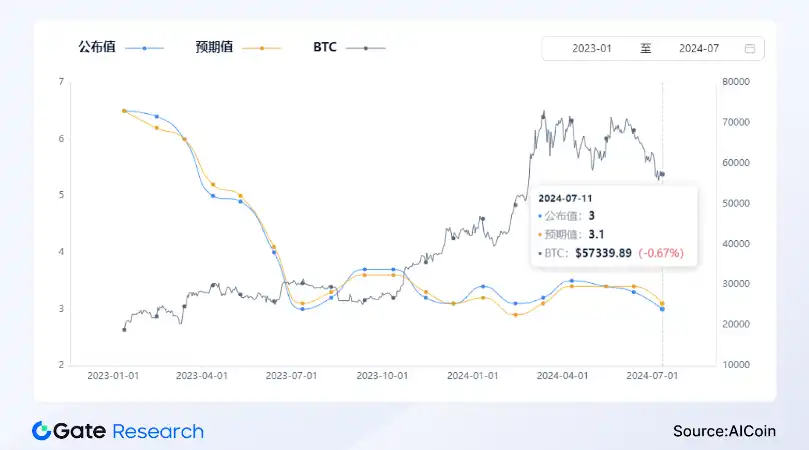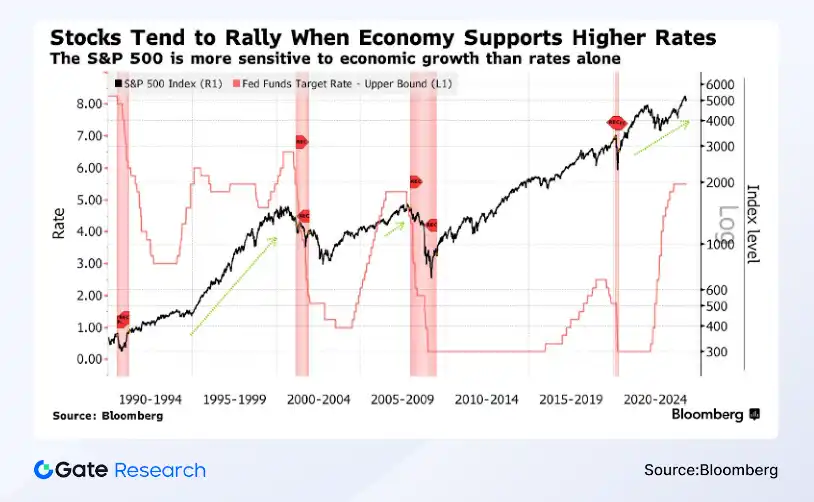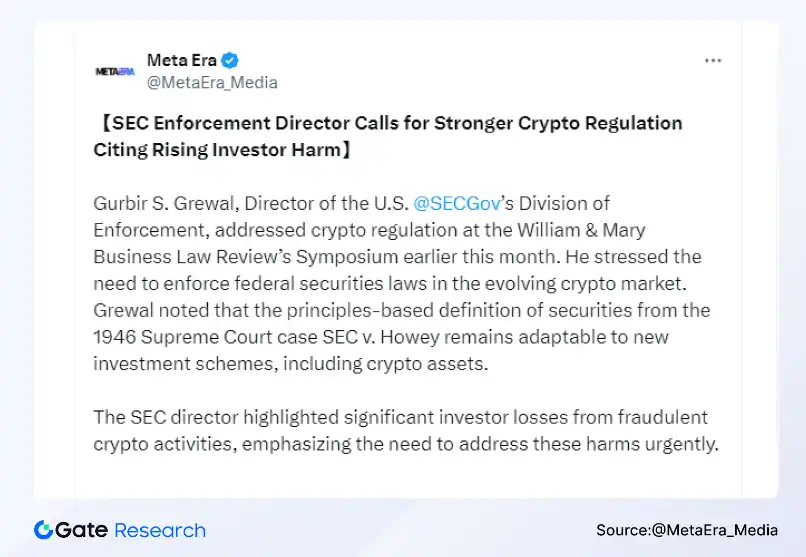U.S. Federal Reserve Chairman Jerome Powell recently expressed the view that three inflationary data are conducive to interest rate cuts. The market generally expects that the U.S. Federal Reserve may implement two interest rate cuts this year. This series of interest rate cuts is expected to significantly increase the liquidity of funds in the market. It has a significant positive impact on the cryptocurrency market, indicating that more funds may flow into the field.
summary:
- After the June CPI data was released, the market generally expected that the US Federal Reserve might take interest rate cuts in September, and US Federal Reserve officials also publicly stated that the time to cut interest rates was approaching.
- In the short term, interest rate cuts by global central banks represented by the U.S. Federal Reserve have undoubtedly injected a boost into the cryptocurrency market. As market liquidity increases significantly, expectations of interest rate cuts will directly trigger market optimism.
- The prelude to interest rate cuts initiated by global central banks has brought new opportunities and challenges to the crypto market, which requires comprehensive analysis and rational participation by investors.
introduction
Recently, when inflation failed to reach expected control targets, the Bank of Canada and the European Central Bank cut interest rates ahead of the traditional path in response to the global economic slowdown and economic pressure in various countries. Although the U.S. Federal Reserve has not yet officially cut interest rates, given the significant slowdown in inflation data in the past three months, U.S. Federal Reserve officials have hinted that the time is ripe for a rate cut. The market expects that the U.S. Federal Reserve may start to cut interest rates in September, and the crypto market is As expectations of loose liquidity begin to rebound, this article will discuss this in detail.
Europe cuts interest rates first, and the U.S. Federal Reserve is about to follow suit
Recently, the Bank of Canada and the European Central Bank, which are followers of this round of interest rate hikes, have taken the lead in cutting interest rates when inflation is higher than the target in order to cope with the slowdown in global economic growth and the multiple economic pressures faced by various countries.
Although the European Central Bank has taken the first step to cut interest rates, the U.S. Federal Reserve has not yet cut interest rates. However, as the CPI data in June turned negative for the first time in four years, the core year-on-year growth rate hit a new low in more than three years. U.S. Federal Reserve officials The time to publicly announce an interest rate cut is approaching, and the market generally expects that the U.S. Federal Reserve may begin to take interest rate cuts in September.

In fact, Fed Chairman Powell has made many speeches on inflation and economic conditions recently, which has revealed the Fed's subtle attitude towards policy adjustments. In his statement this week, he further stated that the slowdown in inflation and economic activity is basically consistent with the U.S. Federal Reserve's expectations, especially the second quarter inflation data, which to a certain extent strengthened the market's expectations for a decline in inflation. Confidence, especially the rate of price increases, is steadily falling towards the 2% target set by the US Federal Reserve, which indicates that the window for interest rate cuts may be about to open.
He also mentioned that the labor market is currently in a more balanced state, and any unexpected weakness in the future will also be one of the considerations in adjusting interest rates.
The market reacted strongly to this dovish tone. CME's FedWatch tool shows that the market generally expects the US Federal Reserve to announce an interest rate cut at its September policy meeting, and this expectation has almost reached 100% certainty.
It is worth mentioning that this week the market will pay close attention to key economic data such as U.S. retail sales, industrial output and weekly unemployment claims in June. These data are expected to provide more clues for assessing the strength of the U.S. economy, and in turn affect the Gate Research will continue to follow up and analyze the market's expectations for the timing of the U.S. Federal Reserve's interest rate cut.
Overall, with the easing of inflationary pressures and the adjustment of economic growth expectations, the U.S. Federal Reserve’s interest rate cut has become the general consensus of the market. This is undoubtedly a long-awaited positive signal for the cryptocurrency market.
Will interest rate cuts directly benefit the crypto market? Yes or No
While the market is currently awash with interpretations of the positive impact of interest rate cuts on the crypto market, we are also seeing some cautious analysis.
Generally speaking, interest rate cuts are seen as a catalyst for increased market liquidity, as lower borrowing costs stimulate investors' enthusiasm for investment. This increased liquidity can often filter into emerging markets such as cryptocurrencies, driving up their prices.
In addition, the increase in economic uncertainty in the interest rate cutting environment has prompted investors to seek safe-haven assets. Cryptocurrencies such as Bitcoin have gradually become new hedging and value-preserving options due to their unique characteristics of decentralization, fixed supply, and ease of storage. Naturally, this will further enhance its market appeal and price.
Although the market is full of expectations for interest rate cuts, many institutions generally believe that it is necessary to remain cautious in the complex and volatile market environment. For example, Morgan Stanley strategists predict that U.S. stocks may retreat by 10%, while Goldman Sachs predicts that there will be a large amount of capital outflows from U.S. stocks in August, waiting for the election results to be clear.

This cautious attitude is mainly based on concerns about a possible recession in the U.S. economy. During the financial crises of 2001 and 2008, although the US Federal Reserve implemented interest rate cuts in the early stages, the market briefly reached a high point and then suffered a sharp downward trend. Even though the US Federal Reserve quickly And significantly lowering interest rates has failed to effectively curb the further spread of the crisis. The roots of these two crises can be traced to the subsequent bursting of the dot-com bubble and the real estate bubble, which had a profound recessionary impact on the economy.
As for whether the current interest rate cut policy will repeat the same mistakes and trigger the outbreak of artificial intelligence bubbles or the U.S. debt crisis, thereby dragging down the crypto market, it is still worthy of vigilance.
Under the disturbance of multiple factors, the encryption market may rise steadily
In fact, in the short term, interest rate cuts by global central banks represented by the U.S. Federal Reserve will undoubtedly inject a shot in the arm into the cryptocurrency market. There is no doubt that as market liquidity increases significantly, expectations of interest rate cuts will directly trigger market optimism, which may prompt a wave of rising prices in the cryptocurrency market in the short term, bringing investors the opportunity to make quick profits. Chance.

However, in the long term, the trend of the cryptocurrency market will be affected by more complex and changeable factors, and price fluctuations are rarely driven by a single factor and require comprehensive analysis.
First of all, the strength of economic recovery is one of the important factors that determine market trends. If the interest rate cut policy can effectively boost the economy and improve the overall economic environment, the cryptocurrency market is expected to benefit from it and enjoy the dividends brought by economic growth. On the other hand, if the economic recovery falls short of expectations and market confidence is frustrated, cryptocurrencies will naturally be unable to survive alone. For example, during the COVID-19 pandemic in 2020, Bitcoin suffered a 312 crash due to the stock market and commodities.
Secondly, inflationary pressure is another factor that cannot be ignored. The central bank's interest rate cuts are intended to stimulate the economy, but they may also trigger the risk of rising inflation. Once inflation is high, the central bank may adjust its policy direction and consider raising interest rates to curb inflation, which will directly put pressure on the cryptocurrency market. Therefore, investors need to pay close attention to global inflation data and central bank policy trends in order to adjust investment strategies in a timely manner.
Furthermore, the US election and changes in the global regulatory environment have a profound impact on the cryptocurrency market. With the rapid development of the market, global regulatory agencies are paying increasing attention to it. While the spot ETFs of Bitcoin and Ethereum are recognized by regulators, they also bring more regulatory attention pressure, so the future regulatory policy trend will still be Directly related to the stability and development prospects of the market.

Despite the many uncertainties, the opportunities that interest rate cuts bring to the cryptocurrency market cannot be ignored. We believe that the monetary easing policies of central banks such as the U.S. Federal Reserve are expected to provide more liquidity support for crypto assets such as Bitcoin and promote the continued development of the market. At the same time, as the regulatory framework gradually improves and the market continues to mature, cryptoassets are expected to exert greater financial value in the future and create more wealth opportunities for investors.
In short, the interest rate cuts initiated by global central banks have undoubtedly brought new opportunities and challenges to the crypto market. This includes factors such as increased positive liquidity and increased demand for hedging, as well as the lessons learned from historical financial crises and other complex factors. challenges. We believe that although there will always be a long-short game in market prices, under the background of a more constructive regulatory framework and the expansion of the adoption of encrypted reality, the innovation and application of digital assets will serve more community users and release more people. More innovative value.





